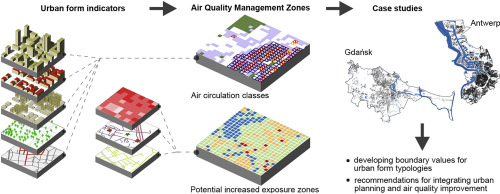当前位置:
X-MOL 学术
›
Build. Environ.
›
论文详情
Our official English website, www.x-mol.net, welcomes your
feedback! (Note: you will need to create a separate account there.)
A framework for Air Quality Management Zones - useful GIS-based tool for urban planning: Case studies in Antwerp and Gdańsk
Building and Environment ( IF 7.1 ) Pub Date : 2020-05-01 , DOI: 10.1016/j.buildenv.2020.106743 Joanna Badach , Dimitri Voordeckers , Lucyna Nyka , Maarten Van Acker
Building and Environment ( IF 7.1 ) Pub Date : 2020-05-01 , DOI: 10.1016/j.buildenv.2020.106743 Joanna Badach , Dimitri Voordeckers , Lucyna Nyka , Maarten Van Acker

|
Abstract There is a growing recognition of the importance of proper urban design in the improvement of air flow and pollution dispersion and in reducing human exposure to air pollution. However, a limited number of studies have been published so far focusing on the development of standard procedures which could be applied by urban planners to effectively evaluate urban conditions with respect to air quality. To fill this gap, a new approach for the determination of urban Air Quality Management Zones (AQMZs) was proposed and presented based on two case studies: Antwerp, Belgium and Gdansk, Poland. The main objectives of the study were to 1) formulate a theoretical framework for the management of urban ventilation potential and human exposure to air pollution and to 2) develop methods for its implementation by means of a geographic information system (GIS). As a result of the analysis, the typologies that may be associated with decreased ventilation potential and the areas that require close monitoring due to potential human exposure to air pollution were identified for both cities. It is advocated that delimiting these typologies – combined with investigating local climate, wind and topography conditions and air pollution characteristics – could constitute a preliminary step in the urban planning process aimed at air quality improvement. These methods can be further applied to other urban areas in order to indicate where detailed studies are required and to facilitate the development of planning guidelines. Moreover, the directions for further research and urban planning strategies were discussed.
中文翻译:

空气质量管理区框架——基于 GIS 的有用城市规划工具:安特卫普和格但斯克案例研究
摘要 人们越来越认识到适当的城市设计在改善空气流动和污染扩散以及减少人类暴露于空气污染中的重要性。然而,迄今为止发表的研究数量有限,重点是制定标准程序,城市规划者可以应用这些程序来有效评估城市空气质量条件。为了填补这一空白,基于两个案例研究提出并提出了一种确定城市空气质量管理区 (AQMZ) 的新方法:比利时安特卫普和波兰格但斯克。该研究的主要目标是 1) 为管理城市通风潜力和人类空气污染暴露制定理论框架,以及 2) 开发通过地理信息系统 (GIS) 实施的方法。作为分析的结果,两个城市都确定了可能与通风潜力降低相关的类型以及由于潜在的人类暴露于空气污染而需要密切监测的区域。提倡界定这些类型——结合调查当地气候、风和地形条件以及空气污染特征——可以构成旨在改善空气质量的城市规划过程的初步步骤。这些方法可以进一步应用于其他城市地区,以表明需要详细研究的地方并促进规划指南的制定。此外,还讨论了进一步研究的方向和城市规划策略。
更新日期:2020-05-01
中文翻译:

空气质量管理区框架——基于 GIS 的有用城市规划工具:安特卫普和格但斯克案例研究
摘要 人们越来越认识到适当的城市设计在改善空气流动和污染扩散以及减少人类暴露于空气污染中的重要性。然而,迄今为止发表的研究数量有限,重点是制定标准程序,城市规划者可以应用这些程序来有效评估城市空气质量条件。为了填补这一空白,基于两个案例研究提出并提出了一种确定城市空气质量管理区 (AQMZ) 的新方法:比利时安特卫普和波兰格但斯克。该研究的主要目标是 1) 为管理城市通风潜力和人类空气污染暴露制定理论框架,以及 2) 开发通过地理信息系统 (GIS) 实施的方法。作为分析的结果,两个城市都确定了可能与通风潜力降低相关的类型以及由于潜在的人类暴露于空气污染而需要密切监测的区域。提倡界定这些类型——结合调查当地气候、风和地形条件以及空气污染特征——可以构成旨在改善空气质量的城市规划过程的初步步骤。这些方法可以进一步应用于其他城市地区,以表明需要详细研究的地方并促进规划指南的制定。此外,还讨论了进一步研究的方向和城市规划策略。











































 京公网安备 11010802027423号
京公网安备 11010802027423号